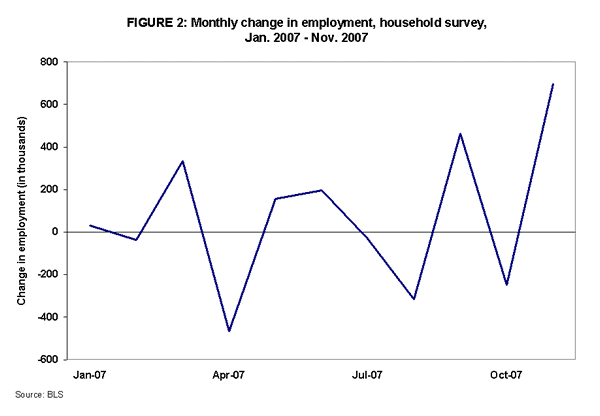December 7, 2007
Another unexpectedly positive month for jobs, but with clear signs of weakness
by Jared Bernstein with research assistance from James Lin
Employers added 94,000 jobs last month, and unemployment held steady at 4.7%, as the nation’s job market remains healthier than expected, according to today’s report from the Bureau of Labor Statistics.
Employment growth has clearly slowed in recent months (see Figure 1), reflecting fall out from the meltdown in the housing market. Revisions in today’s report subtracted 48,000 jobs from the prior two months’ gains, bringing the average monthly increase for the past three months to 103,000, compared to 168,000 in the comparable three month period last year.

Yet, for the second month in a row, payroll job gains exceeded economists’ lowered expectations, suggesting the labor market has yet to consistently reflect the sharply slower growth thought to be occurring in the overall economy. The Household Survey data were particularly strong last month, posting an implausibly large jobs increase of just under 700,000, after falling 250,000 in October. For those who doubt the volatility of this variable, Figure 2 shows the extremely large monthly swings in the Household Survey employment data.

However, the employment-to-population ratio from the Household Survey does provide a much more reliable indicator of job market strength, and after steadily falling this year, it reversed course in November, ticking up three-tenths of a percent, reversing just under half of its 2007 loss thus far.
Today’s report featured both strong and weak points, contributing to a sense of uncertainty about where the job market is headed.
The weak indicators include:
- The housing crunch has clearly taken hold in relevant sectors of the job market. Residential construction and contractors were down 20,000 jobs last month, and EPI’s housing index (residential construction plus real estate and related employment in the credit sector) is falling quickly (see Figure 3).
- Despite solid export growth and a shrinking trade deficit, manufacturing employment again contracted in November, down 11,000. While faster export growth has provided a welcome addition to macroeconomic growth, the fact that factory job losses have continued unabated is disappointing.
- Long-term unemployment spiked up last month to 19.5%, its highest level since May 2005 (these are persons unemployed for at least half a year). While this may be a monthly spike, it is fully consistent with other data showing that, though layoffs are not accelerating, hiring is weakening and leaving more job seekers stuck on the unemployment roles.
- The government sector added 30,000 jobs last month, so private-sector growth was only 64,000. Moreover, net job growth was relatively concentrated in a smaller share of industries last month, as less than half the private-sector industries were adding jobs—the worst read on this indicator since September 2003.

The positive indicators include:
- As noted, unemployment remains below 5%, and the employment rate ticked up, suggesting the job market remains relatively tight.
- Private-sector service employment, a key overall sector, added 97,000 jobs last month and is up 109,000 per month, on average, over the past three months.
- Wages grew 0.5% last month, helping to offset October’s gain of 0.1%. Wage growth was up 3.8% compared to last year, and has stayed consistently in this growth range for months. Today’s labor market provides no evidence of wage acceleration for central bankers to worry about.
- Retail employment posted a solid gain of 24,000 jobs, reversing a string of negative months and suggesting that, even after accounting for seasonal hiring, retailers boosted their staffs last month.
All told, the jobs picture is cloudy. Clearly, employment growth is slowing, reflecting overall difficulties in the economy. Yet, we continue to generate enough jobs to keep the unemployment rate from rising, and enough earnings to provide consumers with some measure of purchasing power.
Amid the uncertainty, two points should be remembered. First, job growth is a lagging phenomenon: it typically slows in earnest six months or so after the overall economy. Second, the economy is widely expected to be slowing sharply in the last quarter of this year, and that slower pace is expected to persist. Thus, six months from now, we may look back longingly at today’s jobs report.
To view archived editions of JOBS PICTURE, click here.
The Economic Policy Institute JOBS PICTURE is published each month upon release of the Bureau of Labor Statistics’ employment report.
EPI offers same-day analysis of income, price, employment, and other economic data released by U.S. government agencies. For more information, contact EPI at 202-775-8810.